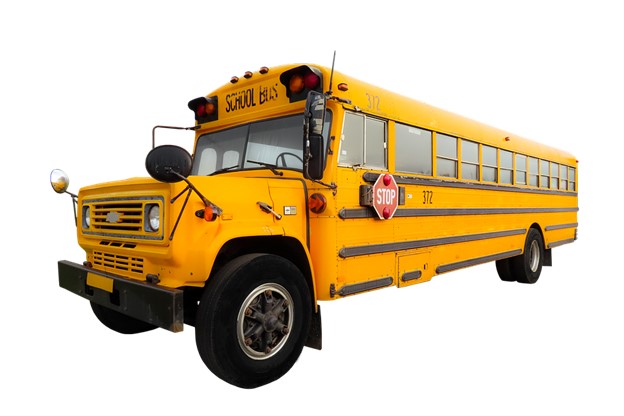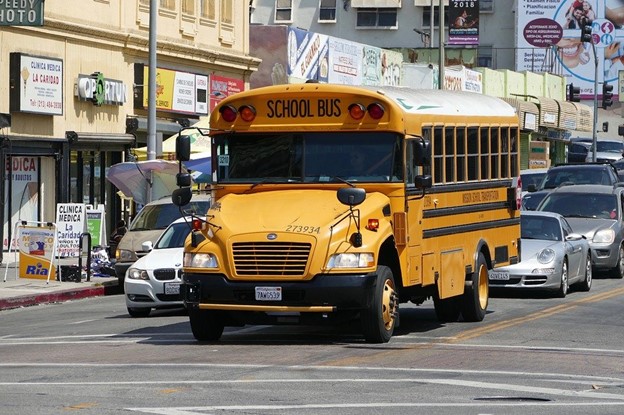
Image Credit: blende12 / Pixabay
For many kids, riding the school bus is a big part of their daily routine. Keeping them safe during their ride to and from school should always be a priority, but it’s become particularly important during the COVID-19 pandemic, which presents extra risk. To keep everyone safe on the school bus requires cooperation from drivers, school staff, parents, and the kids themselves. Here are some key school bus safety tips to consider this year as kids start going back to school.
Safety Tips for Parents
As a parent, you’ll be helping your child get to the bus stop and on the bus, especially when they are younger. There’s a lot you can do as a parent to make sure that your child has a safe ride to and from school - here’s what to keep in mind.
Help your child arrive early
Arriving to the bus stop a few minutes early helps children board safely and have a comfortable ride to school. If they’re running to catch the bus at the last minute, the bus driver may not see them. Not only does an early arrival prevent mishaps, but it can also set the tone for a good day at school. Developing a good morning routine and sticking to it can help ensure that your child is on time to the bus stop each day.

Image Credit: Hreisho / Pixabay
Be careful when you’re driving
If you live near a school bus stop, you should be extra cautious while you’re driving to prevent accidents. Always double check for kids before backing out of your driveway and stay a reasonable distance from the school bus as they pass by. You should also drive slowly through neighborhoods where kids play, and be extra cautious around school bus stops.
Safety Tips For Kids
At the beginning of the school year, parents and teachers should talk to kids about how to stay safe on the bus. The earlier you can build these healthy habits, the more accidents you can prevent. Here are some of the best safety tips for kids riding the school bus.
Wait until the bus has fully stopped to board
When waiting for the bus, kids should stay at least two yards away from the road until the bus pulls up and has fully stopped. They’ll need to wait for the door to fully open and the bus driver to give them a verbal cue saying it’s okay to board before they step onto the vehicle. If kids approach the bus before it has fully stopped, it could result in an accident.
Always cross in front of the bus
Children should always make sure that drivers can see them when crossing the road. They should never cross behind the bus, as this obscures them from the view of the bus driver. When crossing in front of the bus, kids should make sure not to cross too close to the bus, and to double check to make sure the driver can see them clearly. They should also avoid darting in front of the bus or moving too fast, as this makes it harder for the driver to react appropriately.
Stay in your seat while on the bus
It’s very important for passengers to stay in their seats while on the bus to prevent injuries. If there are seat belts, children should use them, but in buses that don’t have them, they should make sure to choose a seat quickly and stay put. They should keep their backpacks and other belongings with them, and avoid putting these items in the aisles or other places where they could get in the way. Kids should not stand up while the bus is moving, and they should avoid putting their head or arms out of any open windows.
Do not distract the driver
Kids can be very energetic, but this excess energy can be very distracting for the bus driver. While it’s okay to talk on the bus, passengers should not yell, play loud music, or move about the bus in a way that could be distracting. If the driver has to keep an eye on the kids’ behavior, it could distract them from the road and be very dangerous.
Use handrails when walking
When going up and down the stairs to get on the bus, kids should always use the handrails for balance. When they stand up from their seats to get off the bus, they should exit in an orderly fashion, taking care to avoid bumping into each other. If passengers do need to stand up while the bus is moving for any reason, they should hold onto the seats for stability.
Safety Tips For Teachers And School Staff
Teachers and school staff members can do their part to help keep students safe on the bus, particularly on their ride home from school at the end of the day. Here are some things that schools can do to help kids have a safe and comfortable bus ride.
Make sure students know which bus to board.
At the beginning of the school year, students may have some confusion about which bus is theirs or how to get home, particularly if they are very young. Have each bus labeled in a way that’s easy for kids to remember - labels can be colors, shapes, numbers, or anything else that kids won’t forget easily. The buses should be lined up in the same place each day as well - this will help avoid any confusion about which bus to board for the youngest students.
Schedule a time for emergency drills.
Buses have emergency exits, and it’s very important that kids know how to use them. While the change of an emergency happening is very low, it’s still crucial that everyone is prepared. Administrators can make time in the school day once or twice a year for students to learn how the emergency exits work and practice what to do in the event they need to be used.
Communicate with school bus drivers regularly.
Ongoing communication between drivers and school administrators can make riding the bus safer for everyone. There should be communication channels open so that drivers can talk with teachers and other support staff members. The sooner you can address any challenges that come up, the safer you can keep the bus for everyone. This is particularly important during the COVID-19 era, where everyone is adjusting to new rules and regulations. These changing rules can cause confusion, but open discussions can help everyone feel more comfortable.
Staying Safe During COVID-19
COVID-19 presents extra challenges for everyone involved at school. In addition to all the normal safety challenges, now you’ll need to take steps to reduce the risk of exposure for both drivers and kids. While it’s impossible to completely take away the risk that comes with a bus ride during this time, there are some small changes schools can make to help everyone feel a little safer and more comfortable.
Cut bus capacity
In the past, kids would sit two or three to a seat on the bus, but right now that approach could be dangerous. When possible, schools should cut down capacity on each bus so that children can stay at least six feet away from each other. This may mean running more routes or running multiple buses per route if the school itself is open at full capacity. Another approach is to divide students into rotating pods, so that they are in school some days and learning from home on other days. To encourage distancing once students are on the bus, drivers may want to add markers to indicate where children should sit, or even consider blocking off certain rows of the bus.
Require drivers and passengers to wear masks
The CDC now recommends that everyone over the age of two should wear a mask to prevent the spread of COVID-19. Wearing a mask protects the people around you by preventing potentially infectious droplets from spreading outward. Recent data has indicated that masks may also protect the wearer when worn correctly.
Schools can prevent COVID-19 from transmitting on buses by requiring everyone on board to wear a mask. Masks should be worn over both the nose and mouth and have more than two layers. To help encourage universal mask wearing, school districts should provide masks for those who need them. Bus drivers should be given masks with filters as well as sneeze guards to minimize the risk for them. They should also have a supply of spare masks on board for kids who may have forgotten theirs.
Parents can help encourage mask wearing by talking to their kids about the importance of wearing a mask. Getting a mask that’s made with comfortable fabric and fits securely can also go a long way towards helping kids keep their masks on all day long. Parents should also help kids wash their masks regularly.
Keep windows open when possible
Having plenty of air flow can also help to stop the transmission of COVID-19. Keeping windows open throughout the bus gets a nice breeze flowing, which can reduce the chance of the virus passing from person to person. School districts may also want to consider installing air purifiers in each bus if they have the resources. While not foolproof, high quality air filters can help reduce the transmission of the virus, particularly during periods of cold weather when drivers will need to keep the bus windows shut.
Of course, in many places it won’t be practical to keep the bus windows open during the colder months. In these instances, drivers should avoid using heat, because the heating system can actually accelerate the spread of COVID-19 in contained areas. Schools should encourage kids to bundle up appropriately to compensate for the colder weather.
Have health supplies available
Giving bus drivers the supplies to encourage good hygiene can be very helpful for preventing the spread of COVID-19. For example, drivers can have a large bottle of hand sanitizer at the front of the bus to encourage kids to wash up. If possible, bus drivers should also use a portable thermometer to check the temperature of each passenger. This may not be practical in particularly crowded school districts, but it could make a difference in areas where bus drivers have the extra time for a temperature screening.
Encourage testing and contact tracing
Many areas of the country now have free testing available for anyone who wants it, regardless of whether they are exhibiting symptoms. School districts should encourage students and staff to be getting tested regularly if they are spending time around others. Students and staff who have a positive test result should be required to stay home for two weeks or until they test negative, without any negative consequences in terms of grading or pay. If someone tests positive, those who have been in contact with them should be encouraged to isolate and get tested as soon as possible to stop the spread. After a positive test, determine what bus the student rode and do not have anyone ride it for at least 24 hours to give the virus time to dissipate.
When it comes to school bus safety, implementing effective management tools can play a significant role in ensuring a secure environment for students. Utilizing reliable school bus routing software, such as that offered by Transfinder, can help optimize bus routes, reduce travel time, and enhance communication with parents and school staff. By employing advanced technology, school districts can better monitor and respond to potential COVID-19 cases within the school bus community. In the event of a positive test result, this software can assist in quickly identifying the affected bus and temporarily suspending its use for at least 24 hours, allowing the virus to dissipate and safeguarding the health of other students and drivers.
School buses are a very important service that help students get the education they need. However, it’s very important that everyone at school knows how to be safe on the bus. The sooner you can teach your kids good school bus safety habits, the better. When they learn these safety habits at a young age, they’ll continue them for years to come.



